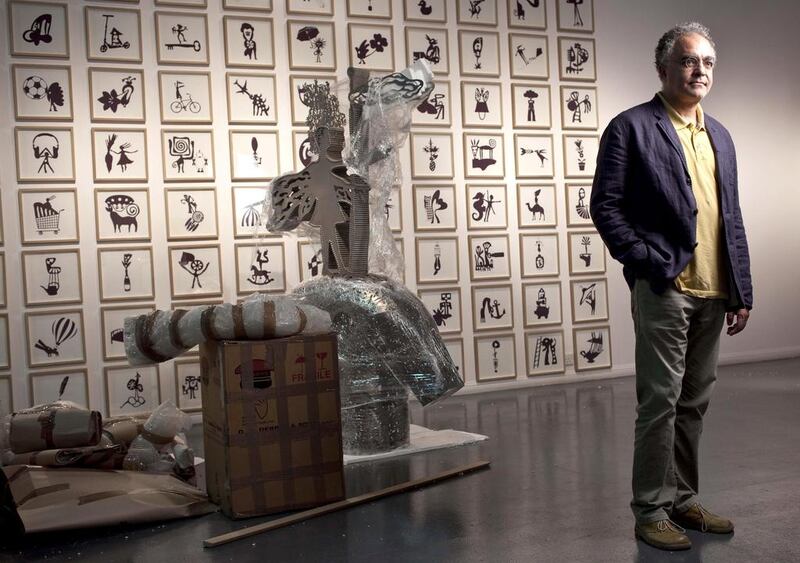Precisely carved from stainless steel and holding a cloud on a sceptre, Hannibal, the ancient Carthagian military commander, looks to the sky with promise and with a visual swirl of thoughts emerging from his head. In 218BC, Hannibal marched from Northern Africa to Rome on a herd of elephants and this week, in Ayyam Gallery in Al Quoz, Dubai, Hannibal is astride one of Nadim Karam’s trademark elephants – the first, the artist points out, to be crafted in three dimensions.
Hannibal and the Elephant is a two-metre-high sculpture that forms a central part of Karam’s solo exhibition, 99 Possible Objects to Find on a Cloud, that opens in Alserkal Avenue tonight.
Karam describes it as the first in a new series of sculptures called Cultural Warriors, his artistic response to the region’s perpetual state of war.
“Art is not religion and it is not dictatorial political system, art is a way to go in parallel with these things, where doubt can make things possible,” he says. “In short, art fragments fanaticism and that is why it is important for artistic voices to become louder in this part of the world. Artists are there to show the other side to the fanatics and the dictators. We come as an army and I have started it here with Hannibal and the Elephant.”
Although Karam is nearing 60, he speaks with the enthusiasm of a 20-year-old and his eyes sparkle as he takes us on a tour of his exhibition – all four tonnes of which has just arrived from Beirut and is still being unwrapped in the gallery. Although the cultural warrior he describes comes in the shape of Hannibal atop his steed, in reality it is Karam himself who is leading this battle, and absurdity is his primary weapon.
The artist, who was born in Senegal but has been living in his native Lebanon since the 1990s, has spent most of his artistic career creating a bizarre visual lexicon. His characters are both human and animal and have exaggerated body parts.
For this exhibition he has created 99 prints that portray an aspect of his artistic language combined with an everyday object. The Wildcat, with three ears, an elongated face and a swirled tail, stands on an upturned shoe, for example, and the boy and girl, who skip through many of Karam’s dreamlike scenes, are balancing on the spires of a castle.
“The 99 things are an expression to say that if you fragment something, you have a starting point for diversity and therefore more understanding,” he explains. “And the word possible puts you into mathematics; 99 is a way to indicate that the possibilities go on and on.”
As he looks at the prints that have just been hung on the back wall of the gallery, Karam genuinely takes enjoyment as if he is seeing them for the first time. When he reads the names of the images he laughs, explaining that he allowed his three children to choose them.
“I have fun but I take my work extremely seriously,” he says. “The only way to understand whatever is happening in our region is to fall into absurdity. I feel there are deadlocks in many places but as you fragment it and lose the fanatic part of it, there is another way to manage it. On a logical level, you can’t reach anywhere; with absurdity you can reconstruct it in a different way.”
Perhaps with absurdity, then, it is easier to take in the darker sides of Karam’s work. The dreamlike connotation of the cloud characters with their endearing features morph into much more sinister scenes in Closets & Closets (2012). Here we witness an inverted plane, a man with bullets coming out of his head and another closing his ears as rockets explode out of them. One man is crying, weighed down by his tears. All are portrayed in a rusted metal, in sharp comparison to the gleaming steel used elsewhere.
In the gallery’s rear partition, Karam has created an entire space called The Agony Room where two twisted metal bodies tower over our heads. A series of canvas paintings with titles such as The Lady of the Levant Under Fire need little explanation.
However, Karam counters that nothing is completely as it seems. Just as when viewed from a distance, there is a blurred line between smoke and clouds, Karam is interested in an innate balance and in a universality that can be found beneath all the varying personal and political agendas in our region.
“In my show you go from very dark things to very optimistic things, but they all have balance. Even the dark side of the moon has light and even in agony we can be creative. I think I show how we can get creativity from all of the holes that are carved in our body.”
So, whether you are pondering on a cloud or blinded by the smoke of war, Karam concludes that the way to move forward is through creativity that ties together the community.
“I am trying to reach the voice of the creative power of the region. It is time for us all to be cultural warriors and not be silenced anymore.”
The Cloud, Dubai
In 2007, Karam and his team at Atelier Hapsitus proposed to install a public piece of art entitled The Cloud in Dubai. The Cloud is a speculative design for a resort city elevated 300 metres in the air above Dubai and is supported on slanting legs resembling rain. They presented it at the International Design Forum as a 20,000-sq-m “landscape-in-the-sky” comprising a lake, gardens, rotating bridges, spiralling walkways, terraces, an auditorium and sky-sports platform. It was something of a dream and was never realised, but it shows that Karam’s interest in clouds began a number of years ago.





